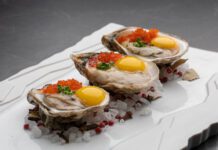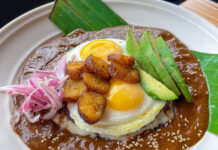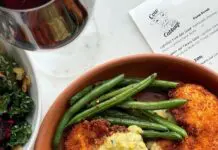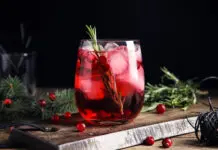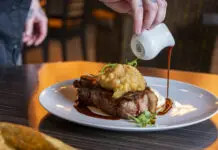The blend of fresh ingredients with spicy heat makes Thai food satisfying yet light. Tulsa certainly has its fair share of great Thai places, and be prepared to add Bamboo Thai Bistro to that list. This small bistro-style restaurant offers traditional Thai favorites (think curries and pad thai) served family style. The Massuman features potatoes, green peas, onions and peanuts swimming in a creamy yellow Massuman curry sauce and is delicious served over rice. Other highlights of the menu include the tom yum soup and princess shrimp. Most dishes come with a choice of protein, including beef, chicken, pork and shrimp. Chinese-inspired stir-fries also occupy a place on the menu; the Orange Medley is a great choice. Most dishes start out at a mild spice level, but diners may request five spice levels: no spice, mild, medium, hot or extra hot. Each meal is served with a complimentary basket of airy shrimp chips. 5079 S. Yale, Tulsa. 918.828.0740.
Cooling Off With Avocado
As a child I could never understand why my mom insisted on making such weird food. Instead of peanut butter and fluff on white bread, she insisted on peanut butter and banana on whole wheat – crusts on. Instead of french fries, we had avocado, sliced, pitted and drizzled with fresh lemon juice, salt, pepper and olive oil.
I felt so different from the other kids, so healthy. If I had only known I was not alone; the avocado is popular all around the world, particularly in South America, Africa and Asia. Today, I can’t get enough of the creamy, soft texture and often split one with my 2-year-old daughter for lunch. While my husband thinks I’m crazy – he’d rather eat cookies, cake, or brownies – Ava gobbles them up as quickly as I do.
You’ve likely sampled this buttery fruit in guacamole and salads. While it tastes more like a vegetable, avocado acts like a fruit – refreshing, nutritious, and especially good in hot, tropical climates. July in Oklahoma is the time of year when I daydream about moving to Canada, but I’ve found it much simpler to make a meal of an avocado to keep myself – and the kitchen – cool.
There are so many ways to enjoy the mighty avocado. In Cape Verde, they mash the ripe flesh with chopped dates for a slightly sweet dip. In many, many countries around the world, avocados are blended into smoothies, such as the grapefruit and avocado version found in parts of the Caribbean. Today, we celebrate two avocado dishes, one from Africa and one from South America. Both are perfect for keeping cool. The first is West African Shrimp in Avocado Boats. Made with simple ingredients, the flavor depends on high quality seafood.
Our second dish is from Bolivia, where they fill avocado halves with fresh salad made with chopped tomatoes, onion, parlsey and vinagrette. Both recipes take only minutes to prepare, but both are beautiful and cooling – perfect for a party in the heat of July.
Sasha Martin is cooking one meal for every country in the world. Her picky husband and baby girl are along for the ride. Join the adventure for recipes, reviews and more at www.globaltableadventure.com.
West African Shrimp In Avocado Boats
Take a voyage to the African coastline with this elegant appetizer or light lunch, a beautiful avocado boat showcasing delicate shrimp. Make the shrimp salad an hour or two ahead and cut the avocados immediately before serving; your guests will never know it only took you a few minutes to throw together.
1/2 lb. frozen cooked shrimp, shelled and thawed?
1 tbsp. ketchup?
1 tbsp. mayonnaise?
1/4 of a fresh lime, juiced?
3 avocados?
Salt and pepper, to taste
Chop shrimp and combine with ketchup, mayonnaise and lime juice. Refrigerate until needed. Immediately before serving, halve and pit the avocados. Fill with shrimp mixture.
Bolivian Avocado Salad??
2 avocados, halved and pitted?
Minced red onion, to taste?
2 small tomatoes, diced?
2 sprigs fresh parsley, minced?
1 tbsp. olive oil?
2 tsp. vinegar?
Salt?and pepper, to taste
Tomatoes have never looked better. Even my picky husband ate this vegan salad right up. Serve slightly chilled but not cold (if the avocado is too cold, you won’t be able to taste the buttery flavor). Make the tomato mixture several hours ahead if you want.
In a small bowl, combine the onion, tomatoes, parsley, olive oil, vinegar, salt and pepper. Pile into avocado halves and serve immediately.
Thank You For Your Submission
Thanks for entering to win our online giveaway. Winners will be contacted via email.
Creating Happiness
Imagine waking up every morning feeling like it’s Christmas. For Oklahoma City artist Suzanne Wallace Mears, that is exactly how she describes her work.
“I am passionate about art from the minute I wake up to when I go to bed,” says Mears. “Hours fly by when I am in my studio.”
Art is meant to invoke an emotional response from its viewer. The purpose of Mears’ bold, colorful, contemporary style is to convey positivity, says the artist.
“My work is bold, colorful, contemporary abstractions of reality, a joyous celebration of life,” she says.
Her work’s upbeat nature is readily obvious. Two of her kiln-formed glass pieces will be at the new Oklahoma Cancer Center, part of the University of Oklahoma Health Sciences Center.
“I am very excited to have my work be in a place where people are going through so much,” says Mears. “People have told me my work makes them feel good when they look at it. It’s my purpose.”
Watching Mears in action just might create some emotions as well. A self-described “messy painter,” Mears is hands-on in all aspects of her work.
“I am a paint slinger,” says Mears. “I even paint with hands instead of a brush.”
This tactile approach shapes her business sense, too.
“I wear a lot of hats,” explains Mears. “I want to be hands-on with all parts of my art. I used to have more than 25 galleries from coast to coast. It was fun to do all that. But now I want to be more in-depth with my pieces.”
Mears reduced the number of galleries to take on a more local approach. You can find her work at the Howell Gallery in Oklahoma City and at Joseph Gierek Fine Art in Tulsa. She also has pieces at galleries in New Mexico and Arizona.
“I also have a space in a showroom in the Paseo District downtown (in Oklahoma City),” adds Mears.
Art has always had a place in Mears’ heart. She still remembers her first piece, a totem carved out of soapstone all the way back in grade school.
College was a bit of an artistic renaissance for Mears. She began taking formal instruction and chose art as her major. After college, Mears became a certified teacher and worked as an art teacher in Iowa.
“It was so rewarding to see the progress and fun (my students) were having,” reminisces Mears.
Family brought Mears to Oklahoma.
“We bought a bank,” explains Mears. “My father-in-law was a bit of a visionary. He saw potential in Oklahoma that many others didn’t see at that time.”
Home for many years now, Mears is an Oklahoman, despite what it says on her birth certificate.
“My art career has been formed here,” says Mears. “I consider myself an Oklahoman even though I was born in Iowa.”
Teaching still has a place in her life.
“I periodically teach private lessons to children and adults,” says Mears. “Sometimes when people buy a piece of (my glasswork) I invite them to my studio to create a piece of their own. I love teaching them how it all works.”
The Curve's Verve
Despite the success he’s built at his Tulsa-based boutique-style Black Optical, Gary Black never intended to open multiple locations or even expand in the existing market.
But that changed two years ago when management for Oklahoma City’s then-new retail center, Classen Curve, began talking to Black about the fledgling shopping destination and the possibility of a second Black Optical.
“When I saw the architecture and plans for Classen Curve, I knew it was the only place we would ever expand into,” Black says. “It’s the only place that could possibly work for us. We deal in clean, progressive products, and Classen Curve sums that all up. Just like Brookside is the place to go in Tulsa in order to see things you won’t see anywhere else, Classen Curve is like that too.”
Today, Black Optical at Classen Curve is open for business and features an elegant and comfortable design that reflects the attention to the aesthetic that defines “The Curve.”
Bob Benham can relate to Black’s experience. The CEO and owner (with his wife) of famed boutique Balliet’s was inspired to move the 75-year-old business to the Curve by none other than Chesapeake Energy CEO Aubrey McClendon.
“Aubrey showed up at my office one day about four years ago and was asking questions about my background and plans for the business,” Benham says. “Aubrey is a visionary and I knew he had something in mind.”
Benham says that just months later, he was approached and asked if Balliet’s would anchor Classen Curve, which Chesapeake was then developing just adjacent to the company’s corporate campus.
“Because of who was planning it, I knew that this would be a (development) that contributed to the economy, which would be environmentally conscious and which would have innovative architecture. The idea was that Classen Curve was to be a walking experience like shopping in a downtown.”
Benham says a deal was struck and Balliet’s made the move to Classen Curve, where today the tony shop enjoys more than 17,000 square feet of space – a 5,000 square-foot increase over its previous location.
“This was a unique opportunity for us economically – to move from a deteriorating area to what I think is the best corner in the city,” Benham says. “We saw Balliet’s as a big part of the renaissance of Oklahoma City.”
Like Black, Benham also cites the architecture and design of Classen Curve as key appeals. Relative to the rest of Oklahoma City and even to the entire state, Classen Curve is indeed innovative and unique.
That was the plan from the get-go.
“Classen Curve represents an architectural and conceptual breakthrough for retail in Oklahoma,” McClendon says. “Oklahomans can see the high standards we set for Classen Curve simply by walking or driving through it.”
“There is nothing like this center anywhere in Oklahoma,” says Rand Elliott, the well-known Oklahoma City-based architect behind both Classen Curve and Balliet’s.
“It is indeed a new idea for Oklahoma City, and we believe one of the most extraordinary retail and restaurant centers in the United States. In essence, Classen Curve symbolizes the maturation of Oklahoma City, and it creates a truly unique place for the best locally-owned retailers and restaurateurs in our community to provide their customers with an incredible experience among businesses which have an affinity for real quality.”
Classen Curve’s trademark design element is the orientation of the outdoor shopping center. Shops face an inner courtyard-style parking lot, fostering a quieter, more private feel.
“The inward parking design is new to us, but it has been done successfully elsewhere,” says Alison Oshel, director of community redevelopment with the Greater Oklahoma City Chamber of Commerce.
“It seemed risky at first. People are used to giant signs on the front of buildings. But consumers seem to like the environment, the feel similar to being in an enclosed area.”
Citing Penn Square Mall as the catalyst for the region, Oshel cites plans for the adjacent Triangle at Classen Curve and the anticipated opening of Whole Foods Market later this year as signs of continued economic development.
Oshel adds that Classen Curve is commanding higher rents than elsewhere in Oklahoma City outside of the mall.
“There is great buzz out there,” Oshel says.
While innovative design is an important component to Classen Curve’s appeal, its resident businesses warrant credit as well. Balliet’s and Black Optical are joined by retailers such as On A Whim, BD Home, Red Coyote and Uptown Kids; and by restaurants such as Café 501, Upper Crust Pizza, Republic Gastropub and Matthew Kenney OKC. A Barre3 also serves the community.
“People love how everything is home-grown retail,” Oshel says.
Shoppers seem to love Classen Curve if numbers are a measure.
“Business has been tremendous,” says Benham. “We’re up 46 percent since the move, even though we’re just now emerging from a recession.”
Black says his decision to expand into Classen Curve was a “no-brainer.”
“There is no other place in Oklahoma City that we would really fit,” Black says.
Like Oshel, McClendon says he believes that Classen Curve and the development of the Triangle at Classen Curve will spur additional growth.
“The opening later this year of Whole Foods will mark a new chapter in the development of the area,” McClendon says. “The Triangle at Classen Curve will be home to one of the nation’s most recognizable and respected retailers, which will prompt other exceptional national retailers to strongly consider locating here.”
In the meantime, more residents discover Classen Curve every week.
“It’s become a destination and we hope it leads to more creative development in the city,” says Oshel.
Runway Reboot
Her tan is perfect. She must have spent hours on that hair – after she finished her makeup. The “flippers” cover the unsightly gaps left when she lost those teeth. Her bathing suit is cut high and those heels push up a pair of perfect calves. The room’s lights go down, the spotlight hits the catwalk and she struts like a model, turning and twirling to give the judges the best views. A beauty pageant, after all, is a beauty pageant. Even if she’s only 8 years old.
San Francisco “pageant mother” Kerry Campbell was in trouble with authorities only a week after a Good Morning America piece during which she cheerfully admitted that she regularly injected her 8-year-old daughter, Britney, with Botox. According to mom, Britney was losing her competitive edge in her beauty pageants. After the San Francisco Human Services Agency removed Brittney from her mother, Kerry admitted that her Botox admission was a fabrication.
Glitz pageants leave most parents with an unsettling feeling.
“Even though I really love this industry, I want my child to be normal. I want her to just be a child. Putting a little girl in those pageants is a little bit extreme,” says Heather Rouba, Mrs. Oklahoma 2009.
She feels that parents that push their daughters in that direction may be living through their children, may be overcompensating for some deficiencies of their own, or have other issues that their daughters are paying for.
“When you take a child and put her into (a glitz pageant), her existing character traits are completely different (than those of older women). They’re focused on basic accomplishments in school, playing, laughing and learning how to be friends. Improving children works in a natural pageant setting. They’re set up to reward children with excellence in areas that children should have excellence in,” says another former Mrs. Oklahoma, Stacy Kukal.
“Putting kids into a glitz pageant says, ‘God didn’t make you right to begin with. We’re all going to get together and see what we can do with you,’” Kukal continues. “Generally, those kids end up with confusion about who they were to begin with.”
There are, however, alternatives to the glitz pageant circuit. “Natural” pageants allow young girls to perform factory-ready, emphasizing skills and talents, not hair extensions. Contestants can’t use makeup in natural pageants. Glitz pageants have swimwear competitions. Interviews weigh more heavily in the scoring of natural pageants. Wigs, false teeth and other enhancements are fair game at glitz pageants.
Kukal’s 6-year-old, Georgia Rose Matlack, a natural pageant competitor, is the current International Junior Miss-Jr. Princess, the title given to the winner of the largest natural pageant for her age group.
A young girl’s driver for winning a pageant should come from a desire to improve herself in positive, authentic ways. That, says Kukal, is what the whole pageant system was built for.
“When you’re judged on the way you look, you’re going to want to put a lot of emphasis on that, a lot of value on that. So I feel like it’s better as a child and as a young person to develop your character. Even being the person I am and knowing that I would have loved pageants as a child, I really feel like it was the best thing for me to wait and go get it on my own. I appreciate it more because of that,” says Rouba.
But “glitz” pageants are big business. There are more than 25,000 glitz child pageants annually. It’s a $1 billion industry, and a lot of money changes hands. Coaches and choreographers get a cut. Makeup artists get a cut. Airbrushed tans aren’t free. Dressmakers can pull in $2,000-plus per gown. There are travel expenses. Entry fees pile up.
Toddlers & Tiaras, TLC’s reality TV show about glitz pageants for the third grade set, pulls in a more-than-respectable 1.4 million viewers each week. There’s no shortage of actual pageants, but the blog posts on the show’s website suggest that many viewers tune in because, for a reality TV show, it’s fantastically surreal.
Whitney Grubbs and her 2-year-old sister, SamiJo Grace, have appeared on the show twice. Grubbs says the pageants have helped her sister with her self-esteem and also turbo-charged her social development.
Grubbs dismisses detractors that claim the glitz pageants are less than healthy for competitors.
“I can see the point when people go to the extreme like the lady with the Botox, but for these girls it’s just fun. It’s just dress-up to them. Every little girl likes to play dress-up. They just get to dress up and have fun with their friends. It’s just a good time for them. These girls are so young that it’s not about the competition. She’s only two. She just likes to get up on stage and dance and entertain everyone,” she says.
Nonetheless, Grubbs is adamant about pulling SamiJo out of pageants before she hits 8 years old. That, Grubbs says, is when the pageants get far too competitive, the parents go way too far to win and the kids pay the price.
“It’s tough in the pageant world. The kids are harsh,” Kerry Campbell said during her controversial Good Morning America appearance.
Of course not every parent of young girls in glitz pageants shoots up their little contestants with Botox. But to many, the spray-on tans are questionable enough.
Dine With A Celebrity
It was a brash yet halcyon age of innocence. It was 1963. John F. Kennedy, who had recently stayed at Tulsa’s fabled Mayo Hotel, was in the White House. Tulsa was Oil Capital of the World. And in that year Mike Samara, a restaurateur from Oklahoma City, moved to Tulsa and opened the Celebrity Restaurant.
Step through the unassuming entrance, and nothing has changed since then. You’re in a world of hushed opulence, bathed by the russet glow cast by chandeliers off gilt mirrors, oxblood walls, swagged white curtains and Louis XV chairs whose pink velvet upholstery and glossy wood is burnished by wear and time. Elegance frozen in amber.
It’s hard to believe that 45 years ago, this place was cutting edge. Back then, most people thought of 31st and Yale, so far from town, as open wilderness, and the Club’s gas-fired grill was one of the first in Oklahoma.
The grill attracted the notice of top gas company executives, the food and service made them bring their friends, and the Club soon became the haunt of the reclusive, powerful elite that ran the city. It was a late-night hotspot. “A hopping place,” people called it.
To be allowed to serve liquor, it was run as a private club. Willie Nelson, according to legend, was refused membership because he refused to wear a jacket and tie. Things have changed; the restaurant is no longer private, and on his latest visit, Mr. Nelson and his friends ordered 60 plates of fried chicken.
But not much else has changed. Old-fashioned is a term of pride at Celebrity. Many employees have been there for 15 years or more, and some of the customers have been coming for 40. Some are middle-aged couples that first came on prom night; others celebrate the anniversary of the night they first became engaged at Celebrity, often requesting the same table. That table is covered with crisp, spotless linen; shortcuts and cutting corners are taboo at Celebrity Club.
Though quite a few celebrities – from Mickey Mantle to David Cook – have dined there, the true celebrity is Samara. He’s built his business on making people feel welcome. He’s in his late 80s and his eyesight is failing, but whenever health permits he’s at the door, greeting customers, recognizing regulars by the sound of their voice.
The menu isn’t long and hasn’t changed all that much since the club’s salad days, but the old-style signature dishes are so well made that they draw those regulars back three, four, even five times each week.
Cold-water lobster tails (no imposter Caribbean lobsters here); succulent strips, rib eye and filet mignon; juicy chicken fried in a cast-iron skillet. Whether you’re there for the food, for the warm welcome, for the piano player who regales the bar area on weekends or, at year’s end, for the elaborate Christmas decorations that take three days to put up – whatever you do, don’t miss the Caesar salad. Prepared tableside by Samara’s son Nick using a classic recipe, a perfect blend of raw eggs (don’t worry, they’re pasteurized), Worcestershire sauce and anchovies, it’s a taste of old-world perfection you won’t find anywhere else. Just like Celebrity Club. 3109 S. Yale, Tulsa. 918.743.1800.
The Giver
Lynn Schusterman and her husband, the late Charles Schusterman, established a family foundation in 1987 dedicated to spreading the joy of Jewish living, giving and learning around the world and to enhancing the quality of life in Tulsa. You can see buildings around Tulsa, from educational institutions to public libraries, burnishing the Schusterman name. Lynn recently signed Warren Buffett’s Giving Pledge. She also authors articles and opinion pieces for publications across the nation on various topics, including women in philanthropy.
The Schusterman Family Foundation bases our giving on helping people move out of circumstances they were born into. I think that the most important aspect of philanthropic giving is empowering people to realize their full potential. When Charlie and I began the foundation, we operated under the thought that if you give a person a fish, you feed him, but if you teach a person to fish, he can feed his family.
One of the causes I’m thrilled about (funding) is Teach For America; it’s helping kids in underprivileged, under-taught areas get an education. That’s one of the things I enjoy and how we base what we do. I can already see the impact Teach For America is having.
I became involved in Birthright Israel at its inception 13 years ago. Part of why I became involved in Birthright is because I am a product of birthright. When Charlie and I were married and had our young family, we decided that before we went any place in the world, as a family, we would go on a trip to Israel. Before then, I took my Judaism and ancestry for granted, and Israel wasn’t on my radar screen. I fell in love with the country and the people. I began reading about the Holocaust because I thought, “How can I ask others to get involved if I don’t know anything?”
The impact (of Birthright Israel) has been far beyond what any of us dreamed. It has changed the face of Israeli relations, and for young people it has become a rite of passage and has secured a place on the Jewish communal landscape.
We also do a Birthright trip for Teach For America teachers. I think it’s important for people to learn about their roots and their ancestors. Young people today have capabilities beyond anything I will ever be able to do.
They’re still looking for identity. “Who am I? Where am I going? Where did I come from?” The trip impacts Teach For America teachers in how they teach and how they view themselves. These trips have been so successful that we’re looking at doing similar trips for Teach For America teachers of other nationalities, ethnic groups and religions.
There were a few things that compelled me to sign The Giving Pledge. One was to encourage people of all ages and capabilities to join to repair the world, to make it a better place, and to really understand the joy of making it a better world. It’s important to learn that it’s the little things that you do that make a difference. To make someone else’s life a little bit better, a little bit easier, it’s an incredible feeling. I get euphoria from helping people through some projects. Who ever thought a woman from Tulsa, Oklahoma, would become involved in something this large?
Magical Montreal
Arriving on a Friday evening affords the opportunity to quickly and gently acclimate yourself to the particular culture of Montreal. Around twilight, head to Old Montreal for a stroll through its historic streets and narrow passages and enjoy the beautiful lighting of the old buildings. You’ll feel like you were much farther from home than just a few hours out of Boston. Grab a copy of the Montreal Gazette or one of the English language weeklies to find a restaurant or wine bar that appeals to you in Old Montreal, then take a relaxing stroll or cab ride back to your hotel.
Depending on your personal hankering and where you wake up, opt for breakfast at Fairmount Bagels (www.fairmountbagel.com) for a taste of real tradition; or enjoy the famous Eggs Benedict at L’Avenue or crepes at a convenient Chez Cora (www.chezcora.com) location. Walk that breakfast off or bike or taxi up to Mont Royal Summit to orient yourself to the lay of the land from atop the city’s beautiful, impeccably designed hilltop park. Then head back to Old Montreal and enjoy the things that had been closed the previous night like the Point Calliere Museum (www.pacmusee.qc.ca) and Notre Dame Basilica (www.basiliquenddm.org), and a host of unique shops and cafes.
Enjoy lunch in Old Montreal on a café patio, take in the sights and you’ll look and feel like a local. After lunch, it’s time for the tour to continue at Montreal Olympic Stadium (www.rio.gouv.qc.ca), the Montreal Biodome (www.biodome.qc.ca) and the Montreal Botanical Garden (www2.ville.montreal.qc.ca/jardin). Even a casual art fan must also see the Montreal Museum of Fine Arts (www.mbam.qc.ca). Around nightfall, head off to dinner and enjoy French cuisine at Les Deux Singes de Montarvie or sample unapologetically Canadian food at the famed Au Pied de Cochon (www.restaurantaupieddecochon.ca). After dark enjoy plentiful nightlife along Rue Crescent or Boulevard Saint-Laurent.
In inclement weather, take in the cultural sites you might have missed previously or visit Casino de Montreal (www.casinosduquebec.com/montreal) after breakfast on Sunday. Otherwise, enjoy splendid outdoor Montreal on Sunday with a self-guided tour on your own or a rented bicycle. Besides Mont Royal, scenic locations include Parc Lafontaine or Parc Jean-Drapeau for the closest beach park. Alternately, enjoy shopping along boulevard St-Laurent or Rue Sherbrooke before seeking inspiration for your final meal in Montreal from the very convenient RestoMontreal (www.restomontreal.ca).
Stay in Style
With its distinctive European environment, Montreal features all levels of accommodations, ranging from hostels to exquisite, world-class resort hotels, including these options.
Hotel Le Germain is situated in Montreal’s bustling downtown, and its 101 rooms and suites and the common areas are characterized by elements of loft living, with both Eastern and Western design flourishes. Comprehensive amenities for travelers of all stripes and designer accessories accentuate the hotel’s stylish nature. www.germainmontreal.com
Hotel Le St-James is part of Old Montreal history with the actual building dating back to 1870. High-end professional service, timeless elegance and décor all contribute to the historic hotel’s renown. The hotel’s Le Spa pampers guests already delighting in its distinctive nature. www.hotellestjames.com
W Montreal brought an instant sense of hip when it opened and was winner of Conde Nast Traveller UK’s coveted Best New Hotel award and a 2010 Fodor’s Choice distinction. W Montreal is hip and stylish and features room options ranging from “Cozy Room” to “extreme Wow Suite.” Amenities pamper business travelers and tourists, as does the AWAY Spa and W Montreal’s Ristorante Otto. www.starwoodhotels.com
Ink Impresario
Award-winning editorial cartoonist Bruce Plante makes readers of Tulsa World think and laugh every weekday. He has more than 30 years of experience making thoughtful points about important political and social issues – with just one panel and a couple of word balloons. He is syndicated, his work appearing in newspapers and magazines from the New York Times to Newsweek.
Oklahoma Magazine: You’re coming up on three decades of professional cartooning. But when did you actually begin cartooning?
BP: Second grade. I drew a caricature of my teacher. She wasn’t supposed to see it, but she did. She grabbed the cartoon and dragged me into the hallway and started spanking me. She told me that cartooning was never going to get me anywhere. She did that spanking based on how many syllables the cartoon’s sentence had. It just made me try harder.
OM: During your career, which president has provided you with the most material?
BP: Reagan, and maybe Clinton. They’re real close. But probably Reagan.
OM: Which president has provided you with the best material?
BP: (laughs) I guess Clinton. Let’s just say I was for Clinton, voted for Clinton and, coming from Arkansas originally, I was really rooting for him. Then he pissed me off. I kind of vented my spleen, which always makes for better editorial cartoons.
OM: There are many paths that a talented illustrator can take. How did you arrive at political commentary and editorial work?
BP: That started in college. I knew I wanted to be a cartoonist. I grew up drawing characters from Marvel comics and MAD Magazine, that sort of thing. I was a real Spider-Man nut. Loved Thor. I got really bored drawing the stuff we had to draw for fine arts majors at the university. So, I started drawing caricatures at Six Flags Over Texas, just to get my foot in some kind of cartooning. When I got back to the university, I started drawing caricatures at fraternity parties and that sort of thing.Somebody dared me to draw the student government president. I drew it. I gave it to my friend. I didn’t know he worked for the student newspaper, and he gave it to the editor, who printed it. It got a lot of reaction. It was kind of cool. Then the student newspaper editor called me up and asked if I wanted to do this on a regular basis for pay. So I thought, ‘Well, this must be it.’ Then I visited my mentor, George Fisher, and asked him what an editorial cartoonist is supposed to do.
OM: Fisher was a wonderfully talented editorial cartoonist. What sort of stuff did you learn from him?
BP: He’s one of my heroes. He actually changed the community that he worked in with his cartoons. Ever since I worked with him, that’s what my goal has been – make Oklahoma, the state that I’m in, a much better state.
OM: Your topics can be very complex. You only have one panel and one, maybe two word balloons to get your message across.
BP: Twain had a quote: “I have made this letter longer than usual, only because I have not had time to make it shorter.”
It’s harder to write a sentence than it is to write a short story. One thing that’s interesting about this is that (editorial cartoonists) have to rely on what people know. Often, most people aren’t really that familiar with the issue.
Sometimes details I pick out and use aren’t known by most of the readers. When you see a wordy editorial cartoon, that’s the reason we do it – we can’t always count on people being aware of an issue. Sometimes, though, it makes us pick the subjects based on what people know – they’re all going on about Donald Trump now. They’re all going to know about Osama being killed.
OM: You’ve been doing this for a long time. You have to do five of these a week. Has the pressure ever gotten to you?
BP: Nope. It’s just one of those things that is part of life. I’m always thinking about a cartoon, hoping that it’d just hit me. I wish it happened like that more often. Earlier in my career it did. But I’m so used to deadlines now that it’s just not that big a deal. But sometimes that’s why you see a bad cartoon out there.













